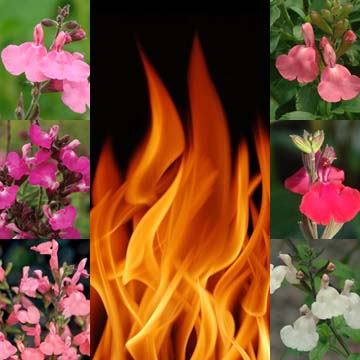Celebrity Salvias: Hot Heatwave Hybrids from Australia

Waterwise landscapes don't have to be cactus gardens if you grow leafy, colorful drought-resistant Salvias, such as the Australian Heatwave™ series. Heatwave™ Salvias are super-tough hybrids of Mountain Sage (Salvia microphylla) and Autumn Sage (S. greggii), which are native to dry, hot summers in Arizona, Texas and Mexico. The two species are closely related and cross easily, so we refer to them as the Salvia greggii and Salvia microphylla group. They're adaptable to many parts of the U.S. and to other nations, such as Australia, that are concerned about water conservation.
The Heatwave™ hybrids are garden celebrities due to being eye-catching, vigorous, easy to grow and sustainable in a time of increasing climate change.
Conserving Water in the Garden
In summer, Australia struggles with hot, dry weather that leads to wildfires in its bush lands and threatens cities including Melbourne, the home of Plant Growers Australia.
PGA is an agricultural and horticultural development company that particularly focuses on developing heat- and drought-tolerant plants for its nation. It is becoming known worldwide for hybridizing a broad range of plants that thrive in heat without daily watering.
At Flowers by the Sea Farm in California, we grow Heatwave™ Salvias because we are serious about water conservation and understand prolonged drought. Our interest in drought resistance has deep roots.
This is a July 2018 update of our article about Heatwave™ Salvias that we first published in February 2015 when the California State Water Resources Control Board had just announced progress in meeting Governor Jerry Brown's challenge to cut outdoor water use by 20 percent from the December 2013 levels.
Xeriscaping as a Solution
Eliminating leafy greenery and converting front yards to gravel or cactus gardens isn't the best way to confront the problem of water shortage. We need flowering plants to cool our environment, clean the air, beautify daily life, feed wildlife including pollinators and provide erosion control.
Also, drought-resistant plants have adaptations that aid water conservation, such as hairy foliage, deep root systems and an ability to decrease flowering during the hottest weeks of the year (sometimes called summer dormancy). All these traits describe Mountain and Autumn sages, which are good examples of the many xeric (low water) Salvias that FBTS raises. Many of our Salvia companion plants are also xeric.
Xeriscape (pronounced zeerascape), which is sometimes referred to as xeric (low water) landscaping, is a better solution for gardening in response to drought or naturally dry climates. The Xeric Choices section of our Everything Salvias blog explains the history and basics of this sustainable gardening method.
When seeking xeric plants in the FBTS nursery online, mail-order catalog, one shortcut to finding low-water Salvias is to peruse the Drought Tolerant section of our Salvias by Culture menu category atop our homepage. Another shortcut is to search our Salvia Finder tool, which allows you to sort choices by USDA Plant Hardiness Zones and characteristics such as flower color, plant size, and cultivation needs including drought tolerance.
Creating Raves with Heatwaves
Howard Bentley and Steve Eggleton developed the Heatwave™ series for PGA. Aside from Salvia, they are known for their work with the drought-resistant Lavandula (lavenders) and Gaura genera.
Bentley and Eggleton crossed many Mountain and Autumn sages to arrive at the intense brights and creamy pastels of their Heatwave™ series. Dense, veined foliage comes from the Mountain Sage parents. In contrast, pure Autumn Sages have much smaller, smooth leaves and an overall airy look.
Both species contribute to the compact form and small size -- about two feet tall and wide -- of the hybrids. As subshrubs, they combine woody growth with soft herbaceous foliage that is deciduous in cold USDA zones and often evergreen in areas with warmer winters.
Similar to their parents, Heatwave™ sages are full sun plants that tolerate some partial shade and appreciate it at the hottest times of year. They bloom off and on from spring into fall and are particularly prolific in autumn.
As with so many Salvias, they attract helpful pollinators but deter deer. After becoming established, the Australian hybrids require an inch or less of supplemental water weekly depending on local conditions. They adapt to a number of soils, but require good drainage.
Here are some quick details and links to the individual plants we grow and sell through our FBTS Mail-Order Nursery.
Salvia microphylla 'Heatwave Blaze' (Heatwave Red Mountain Sage)
- Bright, fuchsia red flowers
- Attracts butterflies and hummingbirds
Salvia microphylla 'Heatwave Brilliance' (Brilliance Pink Mountain Sage)
- Cerise or deep reddish-pink flowers
- Attracts honeybees and hummingbirds
Salvia microphylla 'Heatwave Glimmer' (Glimmering White Mountain Sage)
- Cream-colored flowers with pink blush
- Attracts butterflies and honeybees
Salvia microphylla 'Heatwave Scorcher' (Scorching Pink Mountain Sage)
- Hot pink flowers
- Attracts butterflies and hummingbirds
Questions About Pollinators and Xeric Gardening
One thing you may notice in our Heatwave descriptions is the variations in the kind of small wildlife they attract. We base these statements on what we observe in our own gardens. If you have questions about plants for wildlife gardening or about the Heatwave™ series and xeriscaping, we're always ready to share what we know. Please call or email us. At FBTS, we're dedicated to helping you create lovely, sustainable landscapes.
 Salvia microphylla 'Heatwave Sparkle'
Salvia microphylla 'Heatwave Sparkle'  Salvia microphylla 'Heatwave Scorcher'
Salvia microphylla 'Heatwave Scorcher'  Salvia microphylla 'Heatwave Radiance'
Salvia microphylla 'Heatwave Radiance'  Salvia microphylla 'Heatwave Glow'
Salvia microphylla 'Heatwave Glow'  Salvia microphylla 'Heatwave Glitter'
Salvia microphylla 'Heatwave Glitter'  Salvia microphylla 'Heatwave Glimmer'
Salvia microphylla 'Heatwave Glimmer'  Salvia microphylla 'Heatwave Brilliance'
Salvia microphylla 'Heatwave Brilliance'  Salvia microphylla 'Heatwave Blaze'
Salvia microphylla 'Heatwave Blaze'  Salvia microphylla 'Heatwave Blast'
Salvia microphylla 'Heatwave Blast' 
Comments
There are no comments yet.